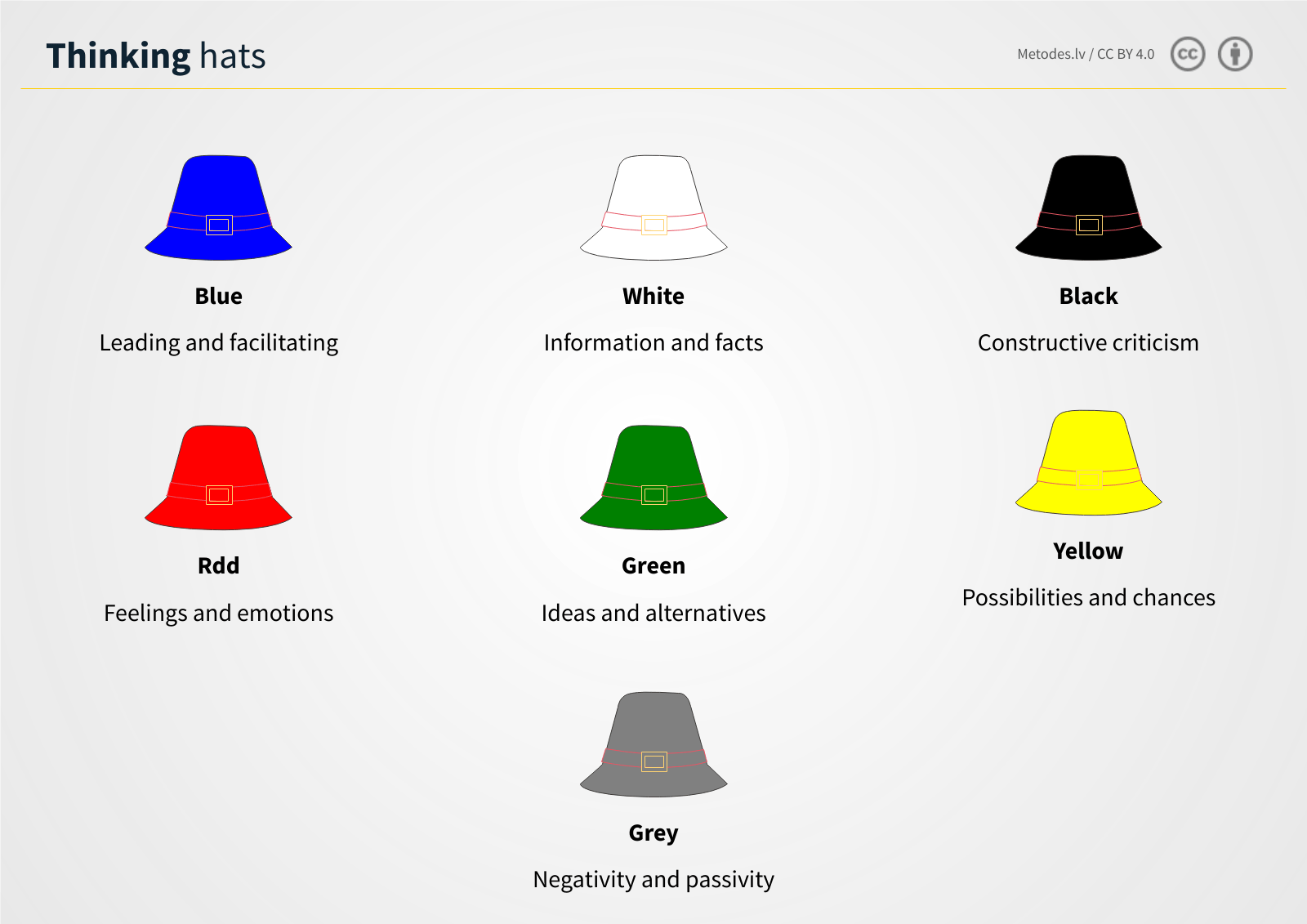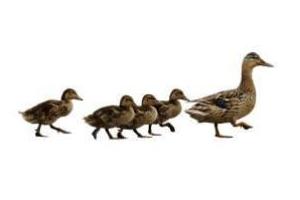This method facilitates group discussions by drawing attention to roles that should be covered when discussing problems and by ensuring that participants do think in a similar direction.
< 24 pers.
13 – 120 min.
Hand-out / presentation for demonstrating the thinking hats (poster, slide, drawing on flipchart…)
Outline
This method is based upon Edward de Bono’s “Six thinking hats”.
Before starting the group discussion, participants are introduced to the seven thinking hats and what they represent. If during the subsequent discussion the moderator or other members of the group feel that the process becomes ineffective because people are overly critical and negative, are too self-content with what has been achieved, or lack alternative ideas, he/she invites the participants to address the topic with the respective thinking hat, for example, the green hat for focusing on alternative solutions or the yellow hat for focusing on how things can be achieved.
The seven hats

Blue hat: Leading and controlling processes
Actions that reflect this role:
- Stepping aside and seeing the bigger picture.
- Clarifying the task.
- Controlling time.
- Ensuring that everybody contributes to the discussion.
- Preventing deviation.
- Structuring information, rephrasing, summarising.
- Assessing what has already been achieved and what still needs to be done.
- Making decisions.
White hat: Facts and information
Actions that reflect this role:
- Offering information, sharing experiences, giving examples.
- Listening to other opinions, asking questions.
- Placing information into the bigger picture.
- Clarifying what is known and what needs to be explored.
Black hat: Constructive criticism
Actions that reflect this role:
- Offering constructive feed back.
- Preventing the group from falling in love with its idea.
- Looking for reasons why an idea might fail.
- Looking for possible side effects of a proposed solution.
- Avoiding conformism, playing the “devil’s advocate”.
Red hat: Feelings and emotions
Actions that reflect this role:
- Listening to one’s intuition, taking seriously any remaining doubts.
- Considering how one feels about a problem.
- Taking into account the emotional dimension of a proposed solution.
- Encouraging others to express their emotions and offering them support when doing so.
Green hat: Ideas and alternatives
Actions that reflect this role:
- Looking for the possible alternative causes of a problem.
- Looking for the second best solution (which is often better than the initial idea).
- Generating alternative ideas, looking for unorthodox solutions.
- Looking for ways to improve current solutions.
Yellow hat: Possibilities and chances
Actions that reflect this role:
- Focusing on how things could be achieved.
- Looking for the positive aspects of a bad idea.
- Taking risks.
- Looking for possibilities, not for problems.
Yellow hat: Possibilities and chances
Actions that reflect this role:
- Focusing on how things could be achieved.
- Looking for the positive aspects of a bad idea.
- Taking risks.
- Looking for possibilities, not for problems.
Grey hat*: Negativity and passivity
* The grey hat is not part of Edward de Bono’s original “Thinking Hats”. However, including the grey hat can help to raise awareness of any negative behaviour in the group that needs to be addressed.
Actions that reflect this role:
- Behaving aggressively, intolerance.
- Placing one’s own interests above the group’s interests.
- Dominating, “fighting” for the best ideas, talking too much, not listening.
- Fishing for sympathy.
- Not addressing the task seriously, trying to be funny.
Comment
There are numerous reasons for ineffective discussions. Participants may take on one role and not want to let go of it, for example, the “eternal critic” who refuses to take part in looking for solutions or for ways in which things could be achieved. Participants may be competing with each other and looking for the weak points in what has been said instead of looking for why or how a statement could be useful. Participants may be self-content with a mediocre idea and stop looking for alternative solutions. And so on.
The “Seven thinking hats” method allows a group to look at a problem from different perspectives. It “puts people in the same boat”, ensuring that they leave their traditional thinking hats behind and think in the same direction, while at the same time avoiding conformism.
Variations
The Thinking Hats may be used to structure the discussion process. For example, begin with the white hat to put all available information about the topic on the table; continue with the red hat in order to see how everybody feels about this; then continue with the green hat to brainstorm possible solutions; and so on.
Another variation is to assign hats to different participants in order to ensure that all roles are represented in the discussion. People should be encouraged not to exclusively stick to their one role but to discuss the topic as they would normally, all the while keeping an eye on the process and drawing attention to their hat colour when appropriate. Participants wearing the grey hat look out for any negative behaviour in the group that should be addressed.

